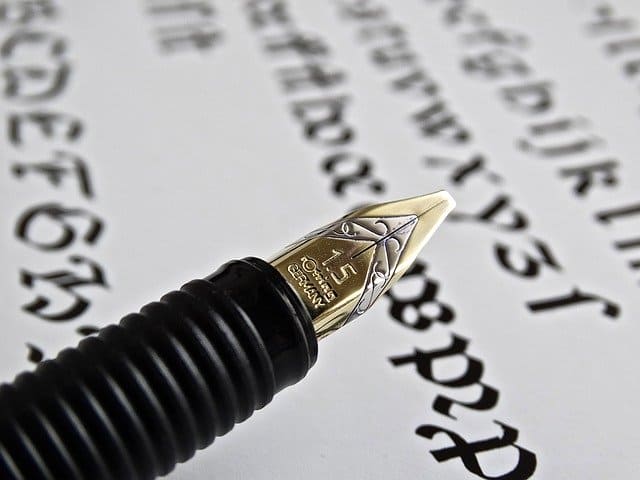When somebody says calligraphy, you usually start thinking about Eastern traditions and art. However, calligraphy is about so much more. It in fact is a very useful and important addition to the skillset of any professional UX/UI designer. And further, you can find many uses for it. If you want to learn more about the potential of calligraphy, keep reading!
The perks of calligraphy for UX/UI designers
People who study the art of writing beautiful letters by hand do it for a few reasons:
- Relieve stress;
- Develop cognitive abilities;
- Get a new profession/monetize a hobby in the future.
A range of studies have proven that calligraphy positively affects brain cells and helps develop mindfulness, observation, and imagination. In 2011, Chinese scientists found that calligraphy improves cognitive functions in older people. When the practice is combined with meditation, it has proven to help people of any age become more calm and relaxed.
However, if you are a designer who works for a professional UI design agency, calligraphy can offer much more than stress relief. Let’s see how you can use this skill to professionally develop and increase your earnings
Learn a Profession and Earn Money
Most industries can benefit from a good calligrapher. Why is that? The uses and utilities are endless. Everything from corporate identities to packaging for products as well as typography in books, advertising, and of course poster graphics. All of these activities need and use calligraphy.
If you are a devoted user of Apple gadgets, you should thank professional calligraphers. Thanks to calligraphy, Apple’s first Mac was the first computer with beautiful typography.
Now let’s look closer at the most wide-spread uses of calligraphy in the industry today.
Branding and Design
Creating corporate identity, logos, and the design of posts in social networks requires beautiful fonts. Of course, small businesses would rather choose something from an already-made collection of fonts that they can download for free online. But their branding will never look as good as an original font developed by a UX/UI design agency specifically for them. These are specifically adapted and created for their unique brand. Meanwhile, large companies will always go for tailored fonts. Such logos are drawn by hand and then converted to digital formats. This makes calligraphy a critical and useful skill in the arsenal of any designer.
Handmade Postcards and Invitations
You can make handmade postcards for loved ones, or you can go even further and take orders and create exclusive crafts. Very often good calligraphy is needed for wedding invitations, baby showers, birthdays, corporate events, and more. If you are just starting out, and need to make beautiful invitation cards faster, ready-made Canva templates with calligraphic fonts are always an option.
Font Creation
Stylized fonts are used in postcards, invitations, and a range of informal documents. Some companies order original fonts as part of their corporate identity. With this type of work, you can have fun and earn a couple of dollars at the same time.
Decorating Clothes
Ordinary white T-shirts, old bags, or sneakers can easily be turned into pieces of art. Labeling can be done manually, or you can draw an image by hand and print it out. Some people even manage to start a whole business by decorating plain things or second-hand items with original designs. It all depends on whether or not you can sell your work!
Interior and Exterior Painting
If you like to work on a larger scale, you can apply calligraphy to walls, floors, and ceilings.
As you can see, calligraphy is not only a soothing and fulfilling practice but can make you a more versatile professional. But how does one begin learning calligraphy? Where does one start?
How to Learn Calligraphy
Today, calligraphy is the art of decorating letters and signs in an expressive, harmonious, and skillful manner.
In calligraphy, letters are written in a single style and similar shape. No matter how intricate your calligraphy is, the text itself should be easy to read.
There are three main types of calligraphy:
- Asian or Eastern
- Arabic or Islamic
- Roman or Western.
Regardless of what type of calligraphy you prefer, there are plenty of materials online that can help you grasp the basics of this ancient art:
- Video lessons on calligraphy is a fun and easy way not to get lost at the beginning of your practice. Try online courses.
- Follow video lessons for beginners that cover the basics of modern calligraphy.
- Get inspired, copying the best examples from the Pinterest free collection.
- Discover more resources about calligraphy.
What You Need to Start Practicing Calligraphy
Calligraphy is an art, so it requires some materials that can be purchased in an art store. Minimum set to start:
- a special pointed pen for calligraphy;
- thick or special calligraphy paper;
- pen holder;
- black ink;
- an ordinary pencil;
- a ruler;
- an eraser.
You will also need water and a non-fibrous cloth, such as a linen napkin, to wipe the feather. A paper towel is also suitable, but its particles can remain on the tip of the pen. To get started, use simple and affordable accessories. There’s no need to immediately buy all of the most expensive and high-quality tools.
Conclusion
Calligraphy is much more than a stress-relief tool or a nice hobby. It can open doors for UX/UI designers and help you drastically increase your earnings. Explore the materials listed in the post and start down the path of this rewarding, ancient art.


